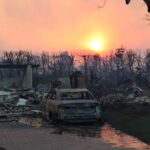U.S. mayors pledged Monday to make their communities more resilient to increasingly severe floods, droughts, extreme storms and wildfires, which they said was more efficient and cost-effective than disaster clean-up afterwards.
Four dozen elected officials, from localities as diverse as Washington D.C., Des Moines, Iowa and Santa Barbara County, California, released a one-page plan which laid out actions such as using more renewable energy and making buildings and infrastructure more energy-efficient.
The Resilient Communities for America Agreement (online at http://www.resilientamerica.org/wp-content/uploads/2013/06/Resilient_Communities_Agreement_Letter.pdf) was launched less than a week after New York Mayor Michael Bloomberg announced a $20 billion plan to prepare his city for rising sea levels and hotter summers.
The actions by local officials took place as anticipation builds that the White House is planning a series of executive actions in July to address climate.
Federal action can help, but local officials are at the front lines of natural disasters, said Des Moines Mayor Frank Cownie. Iowa’s biggest city saw severe flooding in 2008, a trio of “500-year” floods in 2010, a drought in 2012 and the wettest year in 140 years of record-keeping so far in 2013.
“These extreme events are becoming more and more prevalent, and local government is really where it happens,” Cownie said.
He said Federal Emergency Management Agency (FEMA) personnel sometimes are not on the scene until days after disaster strikes, when local officials have already gone ahead with recovery efforts without waiting for federal approval.
“When they show up, it’s good; they’ve got those T-shirts on with FEMA on the back, but they’re just taking notes….We need decision-makers in the throes of an event and we need them immediately,” Cownie said.
El Paso Mayor John Cook said his desert city has been bombarded by wild weather since he took office. Three years’ worth of rain arrived in one week in 2006, causing some $450 million in damage, while in 2011, El Paso’s normally warm weather snapped cold, with temperatures below those of Anchorage, Alaska, for five days, straining local gas lines.
El Paso has spent $100 million to make its buildings more efficient, installing solar panels on library roofs and improving mass transit, with buses that run on compressed natural gas, to cut down on fossil-fueled vehicle traffic.
“The state of Texas should hang their head in shame,” Cook said. “They don’t have realistic goal-setting to use renewable energy.”
(Reporting by Deborah Zabarenko, additional reporting by Richard Cowan; Editing by Cynthia Osterman)




















 Property and Casualty Insurance Trends for 2025
Property and Casualty Insurance Trends for 2025  California Wildfires Will Likely Lead to Large Economic and Insured Losses
California Wildfires Will Likely Lead to Large Economic and Insured Losses  The Most Important 2025 Los Angeles Wildfire Stories; Latest Loss Estimates
The Most Important 2025 Los Angeles Wildfire Stories; Latest Loss Estimates  First 2025 Atlantic Hurricane Season Forecasts 7 Named Storms
First 2025 Atlantic Hurricane Season Forecasts 7 Named Storms 





